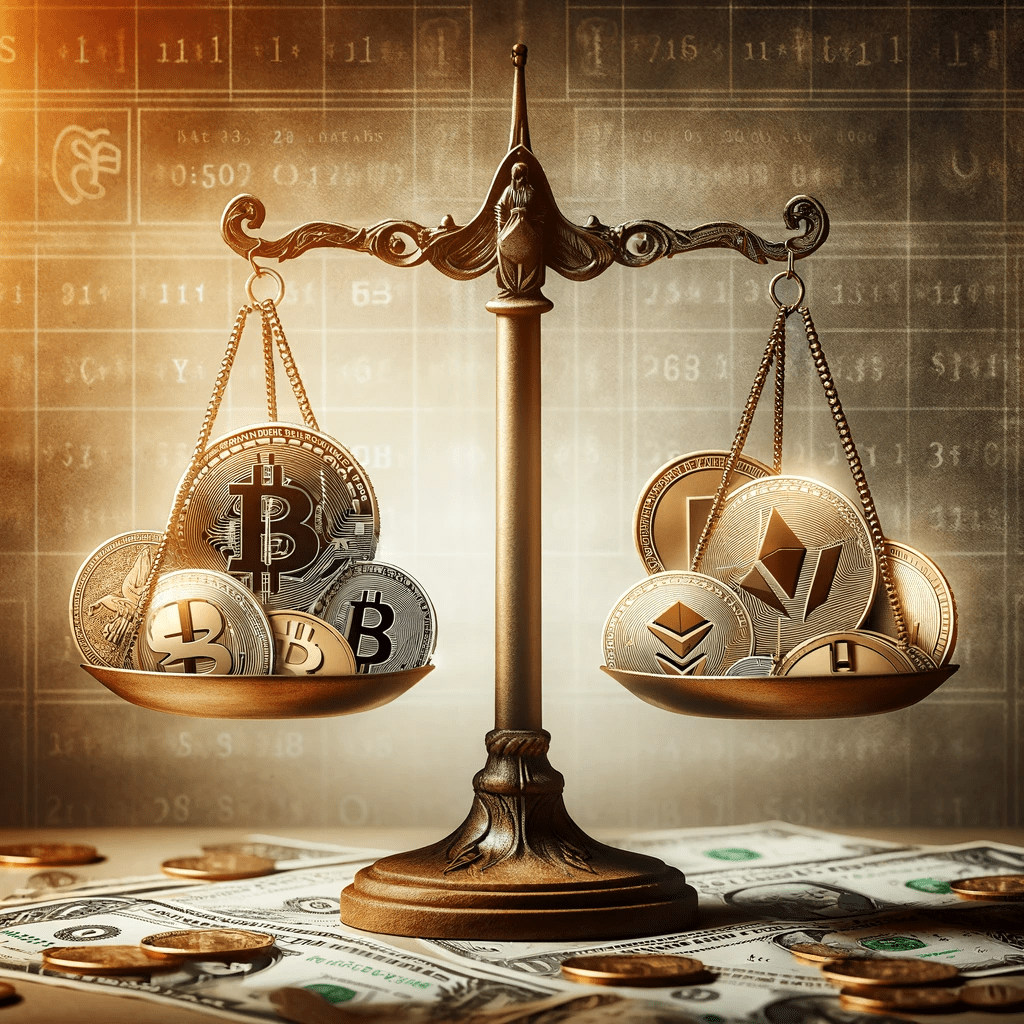Crypto Has No Intrinsic Value Debunked: Basic Economics & Cryptocurrency Valuation
One of the most common objections to Bitcoin and crypto in general is that it has "no intrinsic value". Let's debunk this myth and explore cryptocurrency valuation.Basic Economics & Cryptocurrency Valuation
Why I’ve Written This Article?
One of the most common, and most frustrating, objections (misconceptions) that I hear is that “crypto has no intrinsic value” or “crypto is a form of gambling”. Of course, there are many other common objections too, including:
- “crypto is a scam”
- “crypto is too volatile”
- “crypto is used for illegal activities”
- “the value of your crypto could drop to zero”
- … and many more.
Then, there are those who are interested in investing in a crypto mining rig, but don’t understand what cryptocurrencies are or whether they have any real value.
The purpose of this guide is to debunk the misconception that crypto has no intrinsic value, explain some basic economics, and explore how this relates to cryptocurrency valuation.
So, let’s start with the basics. We’re aiming this at all readers, so please feel free to skip if this isn’t for you.
Key Takeaways
- Economic Education is Crucial: Understanding basic economic principles is key to recognising the value and potential of cryptocurrencies. Money, currency and value are concepts based on trust and agreement.
- Traditional Fiat Currency Has Only Perceived Value: The “gold standard” is gone, meaning today’s currency’s value is backed by government assurance, not physical assets. This is known as perceived value, whereas the tangible value is zero. Unlike cryptocurrencies or gold, which have intrinsic value due to their scarcity and technological utility, the worth of fiat currency is founded on “social contracts” made between governments and their citizens. The value can fluctuate based on factors like political stability, inflation, and monetary policy decisions.
- Cryptocurrencies Hold Real Value: Contrary to popular misconceptions, cryptocurrencies do possess intrinsic value derived from their underlying blockchain technology, security, transparency, and practical utility in various sectors. They also hold perceived value due to factors such as decentralisation and scarcity, which give them an advantage over traditional currency.
- Investing in Crypto Has Parallels With the Stock Market: As well as being considered as digital currencies to rival fiat currencies, owning or mining crypto can draw parallels with owning company shares. Investing in crypto is akin to investing in shares in a company. When you invest in a token, you essentially buy into a part of the cryptocurrency project, much like purchasing shares represents a stake in a company. The value of these tokens can fluctuate based on the project’s performance and market demand, similar to how a company’s stock price varies. These tokens symbolise your investment in the future of the crypto project.
- Digital Evolution: Cryptocurrencies represent a significant step in the evolution of currency, offering an alternative to centralised currencies that are subject to control and inflation. Cryptocurrencies can also offer advantages over traditional money, such as faster transactions, lower fees, and enhanced privacy.
Some Basic Economics
In my parent’s generation, they were taught the three Rs (Reading, Writing and Arithmetic). This seems such a narrow focus compared to modern standards but it still amazes me that one of the most important subjects a person can know, “economics”, isn’t really taught in mainstream UK schools. Not the ones I went to at least.
For this reason, many school leavers earn an income and spend their income without understanding the basics and often get into a lot of debt. This section isn’t specifically about crypto but sets an important basis for everything that follows.
What is Economics?
Economics is all about the production, distribution, and consumption of goods and services.
Often referred to as a “social science“, it impacts our everyday choices and the consequences that follow – every decision from paying taxes to saving for retirement fits within the subject of economics.
As individuals, whether we realise it or not, we engage with economics on a micro level, determining how best to allocate our personal wealth and weighing up the cost-benefit of each purchase we make. Globally, economics can be viewed at a much bigger scale, grappling with national fiscal policies, trade balances, and the complexities of international markets.
What is Money?
Many confuse money with currency, but they’re very different things.
In simple terms, money is a system we all agree to use for buying, selling, borrowing, and saving. It’s like a universal language for trade and commerce.
You can think of money as a trusted tool to exchange your work for things you need or want, like food, clothes, or a house.
What is Currency?
Currency is the name for a particular type of money, like pounds or dollars, used to make transactions easier, whether it’s paper notes, coins, or digital numbers in a bank account.
Historically, gold was used as a form of currency, and it’s often referred to as a “store of value” (a term often used in crypto) for this very reason. However, in today’s modern financial systems, gold is not commonly used as a primary currency and is seen as a precious metal and an investment asset.
Even rare and valuable items like sports cards or collectables can function as a form of currency within certain groups. People often trade these items among themselves, using them as a kind of social currency.
What is Price?
The price of an item is simply what people are willing to pay for it, just like you might pay for a sofa, car, or house.
The price gets set by the seller and the buyer decides whether it’s worth paying. If lots of people want it, the price might go up. If not so many people want it, the price might go down.
As with any kind of purchase, some items are more popular and can be worth more money.
What is Value?
Again, often confused with price, value is how much something is worth.
Value is not just about price tags. It’s about what you and others believe is worth exchanging money for.
For example, a house may have a high value because it provides shelter, comfort, stability, and might increase in worth over time.
Others might value experiences, like travel or education, which enrich their lives and broaden their horizons. Unlike a house, these experiences don’t have physical attributes, but their worth is measured in personal growth, memories, and the intangible benefits they bring.
Value can encompass a wide range of meaningful aspects in our lives.
What is a Coin?
Coins are typically physical tokens used as a means to transact within a money system.
In a traditional sense, a coin is a piece of metal minted and issued by the government, typically used as legal tender for transactions.
Coins have been part of economic systems for centuries.
Historically coins were valued based on the precious metals they were minted from, but nowadays coins are primarily made from less valuable metals like nickel, copper, and zinc, and their face value often exceeds the actual worth of the metal used.
What is a Token?
Tokens, on the other hand, have evolved significantly, especially with the rise of digital currencies and crypto.
In the modern context, a token often refers to a digital asset used in specific platforms or ecosystems. Unlike traditional currency or physical coins, tokens can represent various forms of value – from utility in a specific software system to representing assets like property or stocks.
In essence, coins and tokens embody the concept of value transfer in both physical and digital economies, playing a pivotal role in how we perceive and utilise money in various forms.
Crypto Currencies
Now we have the basics out of the way, let’s jump into the meat of the article – crypto currencies.

Basic economics involved in cryptocurrency valuation
What are Crypto Currencies?
Crypto currencies (or cryptocurrencies) are often considered as digital money.
However, a more accurate description would be a digital currency, as cryptocurrencies function as a medium of exchange, similar to traditional currencies, but in a digital format and typically using decentralised control as opposed to centralised currencies or central banking systems.
Unlike coins and paper money, cryptocurrencies exist only on computers using ‘blockchain technology’ to make sure everyone’s money is safe, secure, and can’t be cheated on.
For more info, please read our article ‘What is Blockchain, Bitcoin and Cryptocurrency‘:
What is a Crypto Token?
A crypto token is simply a unit of currency which can be used within the crypto ecosystem.
It’s built on a blockchain (digital ledger) and is best thought of as a digital coin that you can buy, borrow, hold, save, sell, or trade.
What Is Crypto Mining & Why Do People Do It?
Crypto mining is the process of validating transactions and adding them to the blockchain.
Miners are rewarded with new tokens, similar to earning interest in a savings account for providing a service to the network.
Crypto’s Real-World Utility
When mining tokens from a project with real utility (e.g. a project enabling faster transactions or secure data storage), you’re supporting a system that provides tangible real-world services, much like a company providing a valuable product.
Some of the most popular examples include:
- Ethereum (ETH): Ethereum is known for its smart contract functionality. It allows developers to build decentralised applications (dApps) on its platform. This has real-world implications in fields like finance (DeFi – Decentralised Finance), supply chain management, and even in creating and managing digital assets like Non-Fungible Tokens (NFTs). Read more about Ethereum here.
- Polygon (MATIC): Polygon is a scalability platform for Ethereum, providing faster and cheaper transactions. It enhances Ethereum’s capability, making it more efficient for everyday use in dApps, NFTs, and DeFi projects.
- Chainlink (LINK): Chainlink is a decentralised oracle network. It provides reliable, tamper-proof data for complex smart contracts on any blockchain. This is crucial for financial services, insurance, and other industries that rely on external data sources.
- Ripple (XRP): Ripple aims to facilitate faster, more affordable cross-border transactions. It’s particularly useful for banks and financial institutions, streamlining the process of international money transfers and reducing transaction fees.
Does Bitcoin Have Utility?
You may be wondering about the world’s largest cryptocurrency, Bitcoin (BTC).
Bitcoin is primarily known as a “store of value” (similar to digital gold) and a hedge against inflation, but its real-world utility is more limited compared to the above projects. The reason for this is that Bitcoin’s role is to primarily act as a decentralised digital currency, offering an alternative to traditional fiat currencies.
However, Bitcoin doesn’t offer the same level of functional utility (like smart contracts or decentralised applications) as other cryptocurrencies like Ethereum. Here are a few more important considerations when considering the utility of Bitcoin:
- Bitcoin is not typically the preferred choice for regular transactions or international transfers, especially when speed and low fees are priorities.
- Compared to newer blockchains, Bitcoin’s transaction speed can be relatively slow and the transaction fees can vary significantly, sometimes becoming quite high, especially during periods of high network demand.
- This variability and higher cost make Bitcoin less ideal for everyday transactions or quick international money transfers, where alternatives like Ripple (XRP) or Stellar (XLM) might be more efficient.
- To overcome the above challenges, the Lightning Network enhances Bitcoin’s utility for everyday transactions by enabling faster and more affordable transfers.
- A common strategy is to use Bitcoin as a long-term store of value while using other cryptocurrencies with lower fees and quicker transaction times for day-to-day trading and transfers. This approach combines Bitcoin’s strength as an asset with the efficiency of other cryptos for practical transactions.
What is Crypto Tokenomics?
Tokenomics, a blend of ‘token‘ and ‘economics‘, is essentially the study of how cryptocurrencies work within the broader ecosystem.

Principles of tokenomics when assessing crypto value
It’s not just a fancy term; it delves into the intricate details of how tokens are distributed, used, and valued. It’s a bit like a rulebook that governs a particular cryptocurrency.
Tokenomics shares similarities with traditional economics, especially in terms of supply and demand principles. However, it’s more complex due to the digital and programmable nature of tokens, which allows for more innovative and diverse applications than traditional financial systems. Here are two quite different examples of crypto tokenomics in action:
- Ethereum (ETH): Used to pay for computational resources on the Ethereum blockchain. Its value is tied to the demand for these resources.
- Helium (HNT): Rewards users for providing wireless coverage, with the token being used within its decentralised network.
Is Value a Real Thing?
After exploring traditional economics in the context of blockchain, cryptocurrencies, and Bitcoin, a critical question emerges: ‘Does crypto have value?‘ While this may seem like a straightforward question, it actually requires a more nuanced and psychological perspective to reach an answer, so lets explore this from different angles.
The Real Value of Fiat Currency
The most important thing to realise is that fiat currencies, like pounds, dollars and euros, only have value because governments around the world say they do.
Its value isn’t based on physical assets like gold or any real-world utility but on the stability and economy and the government that backs its value. It can be seen as a kind of social contract between the government and its citizens. This social contract is based on trust and the mutual agreement that the currency will be accepted as legal tender and means of exchange for goods and services.
This trust is fundamental to the functioning of modern economies but it’s also one of fiat’s greatest weaknesses.
When governments make poor decisions then trust collapses, meaning the entire economy can fail.
Examples of this include:
- Zimbabwean Dollar (Hyperinflation): The Zimbabwean Dollar is a classic example where trust in the fiat currency collapsed due to extreme hyperinflation. The government printed excessive amounts of money to pay debts, leading to inflation rates reaching an astronomical amount in 2008/2009, rendering the currency virtually worthless.
- Venezuelan Bolívar (Economic Mismanagement): The Venezuelan Bolívar suffered from hyperinflation due to economic mismanagement, excessive money printing, and loss of confidence in the government’s ability to manage the economy. This led to a severe devaluation of the currency, making it almost valueless and causing widespread economic hardship.
- German Reichsmark (Post-World War I Hyperinflation): After World War I, Germany experienced hyperinflation, partly due to its war debts and reparations. The government printed large amounts of Reichsmarks to meet these obligations, leading to rapid devaluation of the currency. At the height of the crisis in 1923, prices doubled every few days, eroding public trust in the currency and causing major economic turmoil.
What is Legal Tender?
Legal tender is a form of money that is recognised by a government as a suitable means to pay debts, including taxes, and to settle financial obligations. In the case of fiat currencies, their status as legal tender is established by government decree or law, which is what gives them their value and acceptability in economic transactions.
What is The Gold Standard?
Before modern fiat currency was introduced, the US dollar was backed by physical gold, known as the “gold standard“, and worldwide currencies were pegged to the US dollar.

The gold standard is gone but Bitcoin draws parallels to digital gold
Each unit of money represented a certain amount of gold held by the government. This gold standard meant that the currency had a tangible, physical value, reassuring people of its worth.
Due to the limited supply of gold, the gold standard wasn’t subject to money printing and inflation the same as modern fiat currencies are.
The Concept of Real Value
Real value can be both tangible and perceived. A house has tangible value (as it’s a shelter), while a brand name might have perceived value (due to its status and recognition).
In modern economics, value is often about perception and trust, whether it’s for gold, fiat currency, or crypto.
- Gold, for instance, possesses tangible value as it has inherent properties such as rarity and industrial use, making it desirable for jewellery and electronic components.
- Fiat currency on the other hand predominantly relies on perceived value. Its worth is founded on trust in the issuing government’s stability and economic management, with people accepting it as a medium of exchange for goods and services.
- Cryptocurrencies, like Bitcoin, present an intriguing case. They combine elements of both tangible and perceived value. On one hand, cryptocurrencies are built on blockchain technology, which has tangible attributes like secure transactions and decentralisation. Yet, their value largely hinges on perceived factors such as widespread adoption, trust in the underlying technology, and speculation.
This blend of tangible and perceived aspects makes cryptocurrencies a unique asset class in financial markets.
Understanding Intrinsic Value
Intrinsic value refers to the inherent worth of an asset, independent of external factors like market demand.

Real-world utility and intrinsic value of cryptocurrencies
It’s often based on tangible attributes like the physical properties of gold or the productive capacity of a company. This concept contrasts with perceived value, which is driven by factors like supply, demand, and investor sentiment.
So going back to one of the most common objections, that “crypto has no intrinsic value“, let’s consider whether this is true.
The intrinsic value of something, traditionally associated with tangible assets or properties, can be extended to include the utility and technological innovation of cryptocurrencies.
- Blockchain technology as intrinsic value: Cryptocurrencies are underpinned by blockchain technology, which provides intrinsic value through its features like security, transparency, and decentralisation. These features are not just theoretical; they have practical applications in various sectors, enhancing the real-world utility of the technology.
- Utility in crypto projects: Projects like Ethereum and Polygon provide real utility by enabling decentralised applications, smart contracts, and improving scalability. This utility forms part of their intrinsic value, as it’s a tangible benefit offered to users and developers.
- Perceived vs. tangible value: While traditional intrinsic value is often tangible (like gold’s physical properties), the definition needs be broader in the modern technological worls. The intrinsic value of cryptocurrencies includes their technological innovation and the solutions they provide, which, although not physical, are tangible in their application and impact.
- Bitcoin’s value: While its utility as a daily transactional currency may be limited, its value as a decentralised digital currency and a potential hedge against inflation represents a mix of tangible (technology) and perceived (trust, adoption) intrinsic value. The introduction of solutions like the Lightning Network further enhances Bitcoin’s tangible utility.
Crypto Tokens vs. Company Shares
For readers who invest in the stock market, own a company, or hold stocks and shares in an ISA or pension, an analogy can be made to crypto. Holding crypto tokens can be similar to holding shares in a company.
When you buy a token, you’re getting a piece of a crypto project. Like shares, the value of tokens can go up or down, reflecting the project’s success and market demand. These tokens hold value not only because they can be traded or used to purchase things, but also because they represent a stake in the project’s future.
Crypto Tokens vs. Traditional Money
As well as having a stake in the corresponding crypto project, crypto tokens can also be used as a currency.
Unlike traditional money, crypto tokens can offer faster transactions, lower fees, and can operate without the need for banks.
They can also provide a level of privacy and security if used correctly that’s simply not possible with conventional banking.
There are downsides as well, each which come with their own set of risks and require careful consideration.
All that said, it’s hard to argue that cryptocurrencies and crypto tokens have many advantages over traditional money, both tangible and perceived.
How Crypto Projects Generate Revenue?
So, if we compare crypto projects to companies, where investors can own a share or token of that project, it’s important to consider how they generate revenue.
Crypto projects can do this in various ways. For example:
- Transaction fees: Charging for processing transactions.
- Services: Offering unique services or products.
- Partnerships and sponsorships: Collaborating with other businesses.
- Token appreciation: Increasing market cap and value of their own tokens.
When we think of the above, we can start to think about crypto valuation methods.
The success of a crypto project can impact its token value, similar to a company’s stock. If a project grows, offers valuable services, or gains popularity, demand for its tokens may increase, raising their value. Conversely, if the project fails or loses trust, the token value can drop.
Most Common Objections to Bitcoin and Cryptocurrency
Hopefully, the misconception that crypto has no intrinsic value can now be pushed to one side, but what about the other common objections?

Common objections to the legitimacy of cryptocurrencies
Let’s explore and contrast these with the current financial system and fiat currency.
Objection 1 – Bitcoin is Too Volatile to be Used as a Currency or Store of Value
- Objection: Bitcoin’s price fluctuates significantly, making it unsuitable as a currency.
- Response: While Bitcoin is indeed volatile, it’s often seen more as a store of value, akin to gold, and a hedge against inflation. For everyday transactions, other cryptocurrencies with more stability or even stablecoins can be used. In comparison, fiat currencies also experience volatility, though usually less extreme. Many other valuable assets, including stocks, can also be volatile.
Objection 2 – Crypto is Used for Illegal Activities
- Objection: Cryptocurrencies are often associated with illegal transactions.
- Response: While it’s true that crypto has been used for illegal activities, the same can be said for fiat currency and physical money. In fact, crypto is less likely to be used for illegal activities as every transaction is recorded on the blockchain. Research and reports suggest that fiat currency is still more commonly used for such purposes. The U.S. Treasury Department and SWIFT have both indicated that the volume of money laundering through cryptocurrencies is relatively small compared to traditional methods involving fiat currency. The key is in regulation and monitoring, not the currency itself.
Objection 3 – Crypto is a Scam
- Objection: The perception that cryptocurrencies are mostly scams.
- Response: Like any financial system, crypto has its share of scams, but this doesn’t define the entire industry. Traditional banking also faces fraud and scams. For more about whether crypto is a scam click here.
Objection 3 – Bitcoin Will Never be Suitable as a Form of Legal Tender
- Objection: Bitcoin cannot function effectively as legal tender.
- Response: While challenges exist, countries like El Salvador have adopted Bitcoin as legal tender. The success of such initiatives remains to be seen, but it clearly shows Bitcoin’s potential. For more on crypto adoption and crypto-ready countries click here.
Objection 4 – Bitcoin is a Ponzi Scheme
- Objection: Bitcoin is often labelled a Ponzi scheme.
- Response: Unlike a Ponzi scheme, Bitcoin has no central authority promising returns. It’s a decentralised network, more akin to a commodity. For more about whether crypto is a Ponzi scheme click here.
Objection 5 – Bitcoins is Not Backed by Any Government
- Objection: Lack of government backing is seen as a weakness.
- Response: This is true, but it’s also a strength, offering independence from government-controlled monetary policies and money printing. Fiat currencies, while government-backed, are subject to inflation and political influence.
Objection 6 – You Can Lose Your Crypto
- Objection: Security concerns around losing or theft of crypto.
- Response: Security is a concern, but this is true for all forms of wealth storage, whether at home or out and about. Banks and digital platforms also face security threats. The key is to adopt robust security measures.
Objection 7 – Bitcoin Will be Banned by the Regulators
- Objection: Fear of regulatory bans on Bitcoin and crypto as a whole.
- Response: Regulatory challenges exist, but outright bans seem unlikely given the global and decentralised nature of Bitcoin. The following article goes into detail about external factors that can impact Bitcoin, but in summary, the SEC’s attempt to classify cryptocurrencies such as Ripple (XRP), as a security, is failing and indicates a trend towards regulatory involvement aimed at shaping the market rather than prohibiting it. In addition, current expectations are that various Bitcoin ETFs will be approved very soon, indicating even greater acceptance of Bitcoin.
Objection 8 – Crypto is a Form of Gambling
- Objection: The belief is that investing in cryptocurrencies is akin to gambling due to their unpredictable and volatile nature.
- Response: Investing in cryptocurrencies involves calculated risks based on market analysis, technological understanding, and economic principles. Unlike gambling, where outcomes are largely based on chance, crypto investments are grounded in a strategic assessment of market trends, project utility, and technological advancements. While volatility is a factor, it is also a trait shared with other investment forms like stocks and real estate, where value fluctuations are influenced by various market dynamics.
The Evolution of Currency
The notion of currency has come a long way throughout the history of mankind.
In modern times, we’ve seen currency evolve from being backed by physical assets like gold to being underpinned by government assurance. Governments are now working on their own digital currencies called Central Bank Digital Currencies (CBDCs) as an attempt to combat decentralised cryptocurrencies and gain more centralised control over the fundamental way that the currency works, including the supply of that currency and how it’s used. More on CBDCs here.
Along with CBDCs, cryptocurrencies represent the next step in this evolution, offering a decentralised option that’s not controlled by any single entity.
Crypto Valuation
The question of how to value crypto and assess a cryptocurrency valuation is tricky. People look at different things to decide if a crypto is valuable or not. This includes looking at the tangible (or intrinsic) value and perceived value.
Valuing cryptocurrencies involves a variety of factors, each offering a different perspective on its worth.
Fundamental Analysis
- Revenue Generation: Assessing how crypto projects earn through transaction fees, services, and partnerships.
- Technology: The sophistication and security of the underlying blockchain technology.
- Adoption & Use Cases: Widespread use, utility and practical applications in real-world scenarios.
Technical Analysis
- Market Trends: Studying historical price movements and patterns. Read more specifically about Bitcoin price models here.
- Volume & Market Cap: Analysing the total value and trading volume of the cryptocurrency.
Other Considerations
- Rarity: Limited supply can increase perceived value.
- Trust and Confidence: Public perception and trust in the cryptocurrency’s longevity.
- Regulatory Environment: Impact of governmental regulations and legal recognition.
- External Influences: Global economic factors, technological advancements, and major events affecting the crypto market.
Each of these factors contributes to the overall assessment of a cryptocurrency’s value, offering insights into its potential growth and stability.
Remember, what’s valuable to one person may not be to another. So, crypto value can change a lot, and sometimes it’s fast!
Conclusion: Understanding Crypto’s Value in Today’s World
In conclusion, cryptocurrencies are much more than a fleeting trend, speculative bubble or gamble.
They represent a groundbreaking development in the financial world, combining technology and economics in a way that challenges traditional monetary systems. By understanding the key concepts of “crypto valuation” and the real “crypto value”, investors and enthusiasts can better appreciate the potential and resilience of these digital assets. As the world of finance and economics continues to evolve, cryptocurrencies stand at the forefront of this transformation, offering both challenges and opportunities for those willing to engage with them.
Last modified on: April 18, 2025
Latest Posts

GPU Mining, ASICs & Decentralisation Explained
IntroductionMining cryptocurrency has become a popular way to participate in the crypto and blockchain space while...

About CryptosRUs and Into the Cryptoverse
This post exploring CryptosRUs vs Into the Cryptoverse for free crypto advice is a little different to others we...

From Everyday People & General Adoption to the Bitcoin Elites: Who Will Benefit the Most?
IntroductionOn 6th September 2023, we published a massive article titled ‘Detailed Analysis of Projected Bitcoin...

How The Price of Bitcoin is Impacted by External Drivers & Forces
Introduction On 6th September 2023, we published a massive 10K word article titled ‘Detailed Analysis of Projected...
Contact us to order your crypto mining rig today
Address
Opace Ltd t/a Crypto Mining Solutions, Park House, Bristol Rd South, Rubery, Birmingham, West Midlands, B45 9AH. UK
Phone
0845 017 7661
